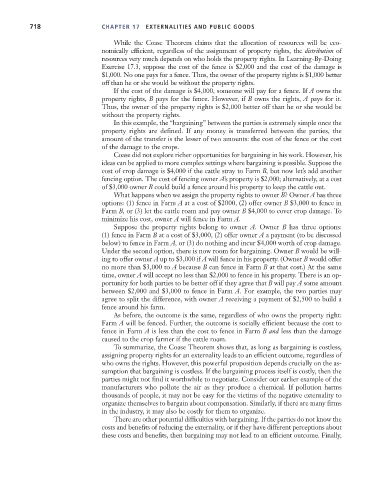Page 744 - Microeconomics, Fourth Edition
P. 744
c17ExternalitiesandPublicGoods.qxd 8/22/10 4:56 AM Page 718
718 CHAPTER 17 EXTERNALITIES AND PUBLIC GOODS
While the Coase Theorem claims that the allocation of resources will be eco-
nomically efficient, regardless of the assignment of property rights, the distribution of
resources very much depends on who holds the property rights. In Learning-By-Doing
Exercise 17.3, suppose the cost of the fence is $2,000 and the cost of the damage is
$1,000. No one pays for a fence. Thus, the owner of the property rights is $1,000 better
off than he or she would be without the property rights.
If the cost of the damage is $4,000, someone will pay for a fence. If A owns the
property rights, B pays for the fence. However, if B owns the rights, A pays for it.
Thus, the owner of the property rights is $2,000 better off than he or she would be
without the property rights.
In this example, the “bargaining” between the parties is extremely simple once the
property rights are defined. If any money is transferred between the parties, the
amount of the transfer is the lesser of two amounts: the cost of the fence or the cost
of the damage to the crops.
Coase did not explore richer opportunities for bargaining in his work. However, his
ideas can be applied to more complex settings where bargaining is possible. Suppose the
cost of crop damage is $4,000 if the cattle stray to Farm B, but now let’s add another
fencing option. The cost of fencing owner A’s property is $2,000; alternatively, at a cost
of $3,000 owner B could build a fence around his property to keep the cattle out.
What happens when we assign the property rights to owner B? Owner A has three
options: (1) fence in Farm A at a cost of $2000, (2) offer owner B $3,000 to fence in
Farm B, or (3) let the cattle roam and pay owner B $4,000 to cover crop damage. To
minimize his cost, owner A will fence in Farm A.
Suppose the property rights belong to owner A. Owner B has three options:
(1) fence in Farm B at a cost of $3,000, (2) offer owner A a payment (to be discussed
below) to fence in Farm A, or (3) do nothing and incur $4,000 worth of crop damage.
Under the second option, there is now room for bargaining. Owner B would be will-
ing to offer owner A up to $3,000 if A will fence in his property. (Owner B would offer
no more than $3,000 to A because B can fence in Farm B at that cost.) At the same
time, owner A will accept no less than $2,000 to fence in his property. There is an op-
portunity for both parties to be better off if they agree that B will pay A some amount
between $2,000 and $3,000 to fence in Farm A. For example, the two parties may
agree to split the difference, with owner A receiving a payment of $2,500 to build a
fence around his farm.
As before, the outcome is the same, regardless of who owns the property right:
Farm A will be fenced. Further, the outcome is socially efficient because the cost to
fence in Farm A is less than the cost to fence in Farm B and less than the damage
caused to the crop farmer if the cattle roam.
To summarize, the Coase Theorem shows that, as long as bargaining is costless,
assigning property rights for an externality leads to an efficient outcome, regardless of
who owns the rights. However, this powerful proposition depends crucially on the as-
sumption that bargaining is costless. If the bargaining process itself is costly, then the
parties might not find it worthwhile to negotiate. Consider our earlier example of the
manufacturers who pollute the air as they produce a chemical. If pollution harms
thousands of people, it may not be easy for the victims of the negative externality to
organize themselves to bargain about compensation. Similarly, if there are many firms
in the industry, it may also be costly for them to organize.
There are other potential difficulties with bargaining. If the parties do not know the
costs and benefits of reducing the externality, or if they have different perceptions about
these costs and benefits, then bargaining may not lead to an efficient outcome. Finally,

